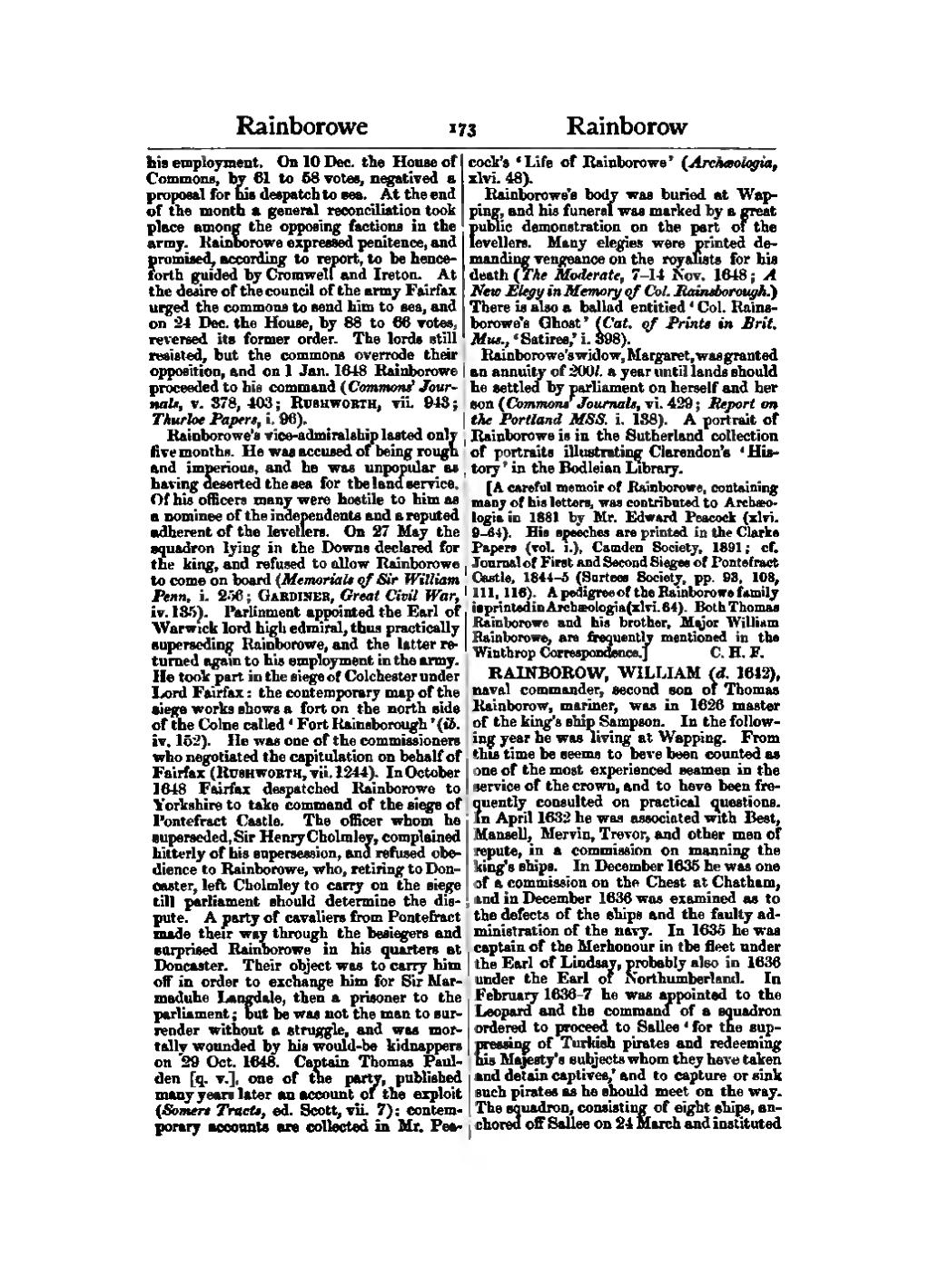his employment. On 10 Dec. the House of Commons, by 61 to 58 votes, negatived a proposal for his despatch to sea. At the end of the month a general reconciliation took place among the opposing factions in the army. Rainborowe expressed penitence, and promised, according to report, to be henceforth guided by Cromwell and Ireton. At the desire of the council of the army Fairfax urged the commons to send him to sea, and on 24 Dec. the House, by 88 to 66 votes, reversed its former order. The lords still resisted, but the commons overrode their opposition, and on 1 Jan. 1648 Rainborowe proceeded to his command (Commons' Journals, v. 378, 403; Rushworth, vii. 943; Thurloe Papers, i. 96).
Rainborowe's vice-admiralship lasted only five months. He was accused of being rough and imperious, and he was unpopular as having deserted the sea for the land service. Of his officers many were hostile to him as a nominee of the independents and a reputed adherent of the levellers. On 27 May the squadron lying in the Downs declared for the king, and refused to allow Rainborowe to come on board (Memorials of Sir William Penn, i. 256; Gardiner, Great Civil War, iv. 135). Parliament appointed the Earl of Warwick lord high admiral, thus practically superseding Rainborowe, and the latter returned again to his employment in the army. He took part in the siege of Colchester under Lord Fairfax: the contemporary map of the siege works shows a fort on the north side of the Colne called ‘Fort Rainsborough’ (ib. iv. 152). He was one of the commissioners who negotiated the capitulation on behalf of Fairfax (Rushworth, vii. 1244). In October 1648 Fairfax despatched Rainborowe to Yorkshire to take command of the siege of Pontefract Castle. The officer whom he superseded, Sir Henry Cholmley, complained bitterly of his supersession, and refused obedience to Rainborowe, who, retiring to Doncaster, left Cholmley to carry on the siege till parliament should determine the dispute. A party of cavaliers from Pontefract made their way through the besiegers and surprised Rainborowe in his quarters at Doncaster. Their object was to carry him off in order to exchange him for Sir Marmaduke Langdale, then a prisoner to the parliament; but he was not the man to surrender without a struggle, and was mortally wounded by his would-be kidnappers on 29 Oct. 1648. Captain Thomas Paulden [q. v.], one of the party, published many years later an account of the exploit (Somers Tracts, ed. Scott, vii. 7); contemporary accounts are collected in Mr. Peacock's ‘Life of Rainborowe’ (Archæologia, xlvi. 48).
Rainborowe's body was buried at Wapping, and his funeral was marked by a great public demonstration on the part of the levellers. Many elegies were printed demanding vengeance on the royalists for his death (The Moderate, 7–14 Nov. 1648; A New Elegy in Memory of Col. Rainsborough.) There is also a ballad entitled ‘Col. Rainsborowe's Ghost’ (Cat. of Prints in Brit. Mus., ‘Satires,’ i. 398).
Rainborowe's widow, Margaret, was granted an annuity of 200l. a year until lands should be settled by parliament on herself and her son (Commons' Journals, vi. 429; Report on the Portland MSS. i. 138). A portrait of Rainborowe is in the Sutherland collection of portraits illustrating Clarendon's ‘History’ in the Bodleian Library.
[A careful memoir of Rainborowe, containing many of his letters, was contributed to Archæologia in 1881 by Mr. Edward Peacock (xlvi. 9–64). His speeches are printed in the Clarke Papers (vol. i.), Camden Society, 1891; cf. Journal of First and Second Sieges of Pontefract Castle, 1844–5 (Surtees Society, pp. 93, 108, 111, 116); Notes and Queries, 6th ser. v. 180. A pedigree of the Rainborowe family is printed in Archæologia (xlvi. 64). Both Thomas Rainborowe and his brother, Major William Rainborowe, are frequently mentioned in the Winthrop Correspondence.]
RAINBOROW, WILLIAM (d. 1642), naval commander, second son of Thomas Rainborow, mariner, was in 1626 master of the king's ship Sampson. In the following year he was living at Wapping. From this time he seems to have been counted as one of the most experienced seamen in the service of the crown, and to have been frequently consulted on practical questions. In April 1632 he was associated with Best, Mansell, Mervin, Trevor, and other men of repute, in a commission on manning the king's ships. In December 1635 he was one of a commission on the Chest at Chatham, and in December 1636 was examined as to the defects of the ships and the faulty administration of the navy. In 1635 he was captain of the Merhonour in the fleet under the Earl of Lindsay, probably also in 1636 under the Earl of Northumberland. In February 1636–7 he was appointed to the Leopard and the command of a squadron ordered to proceed to Sallee ‘for the suppressing of Turkish pirates and redeeming his Majesty's subjects whom they have taken and detain captives,’ and to capture or sink such pirates as he should meet on the way. The squadron, consisting of eight ships, anchored off Sallee on 24 March and instituted
